
This is a list of the National Register of Historic Places listings in Providence County, Rhode Island.
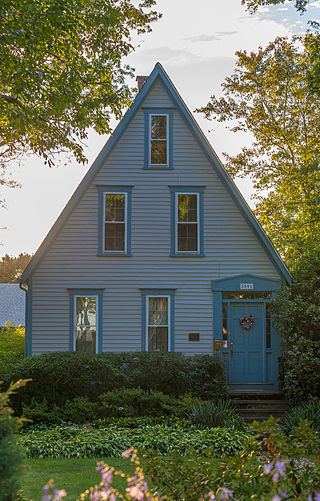
The Bicknell–Armington Lightning Splitter House is a historic house at 3591 Pawtucket Avenue in East Providence, Rhode Island. The house is of a distinctive type, a "Lightning Splitter", of which only a few instances exist in the Providence area. It is a wood-frame structure with a steep two-story gable roof. Records suggest that the house was constructed about 1827, but architectural evidence suggests it was extensively altered in the 1850s. The main entrance and the interior has a simplified Greek Revival styling. The house was listed on the National Register of Historic Places on November 28, 1980.

The James Dennis House is an historic house located at 3120 Pawtucket Avenue in East Providence, Rhode Island. This two-story wood-frame house was built sometime in the 1870s, and is a fine local example of Queen Anne Victorian style. Its most prominent features are a square tower with pyramidal roof, and a decorated porch that wraps around three sides. Although Pawtucket Avenue once had a significant number of such houses lining it, most have been demolished or significantly altered.

Art's Auto is a historic former service station at 5–7 Lonsdale Avenue in Pawtucket, Rhode Island. It is a single-story brick structure with a flat roof and a series of towers capped by pointed roofs. It was erected as an automotive service station in 1927–28 for Arthur Normand at a time when gasoline producers competed, in part, by the shape and style of their service stations. This station is one of two stations known to survive from this period in the state. Its front facade has a dramatic presentation, with square towers topped by pyramidal roofs at the corners, and a projecting round bay in the center topped by a conical roof, with windows arrayed around the bay and on its flanks. The building is currently used as an office for Anchor Financial. Art's Auto was listed on the National Register of Historic Places in 1978.

The Bridge Mill Power Plant is an historic hydroelectric plant at 25 Roosevelt Avenue in Pawtucket, Rhode Island. It is a red brick building, with sections two and three stories in height, located on the west bank of the Seekonk River. An ashlar granite retaining wall obscures a conduit which delivers water to the facility from the Pawtucket Falls Dam. The facility has three parts: a gate house, which controls the flow of water into the power house, where five turbines were located. A boiler house housed a steam generation facility which was used to generate power when the water levels were too low for hydroelectric power generation. Built in 1893, this is probably the best-preserved 19th-century hydroelectric power station in Rhode Island.
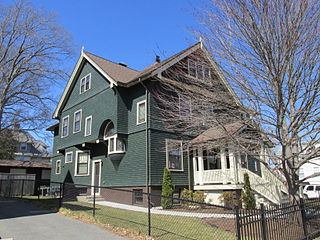
The E. A. Burnham House is an historic house at 17 Nickerson Street in Pawtucket, Rhode Island. It is a 2+1⁄2-story wood-frame structure, with a cross-gabled hip roof plan. Its exterior is finished in wood shingles, with decorative Gothic Revival bargeboard, finials, and other elements. The building's interior contains elaborately carved woodwork, most of which has survived conversion of the building to multiple units. The house was built in 1902 for Eugene Burnham, a local businessman, and is one of the few known designs of local architect Albert H. Humes. The property's garage, which is stylistically similar to the house, may be one of the oldest in the city.
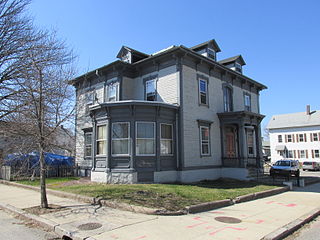
The Childs–Brown House is an historic house in Pawtucket, Rhode Island. It is a two-story wood-frame structure, roughly square in shape, with a low-pitch hipped roof broken by dormer roofs. An ell extends to the rear of the house. Both the eaves and the roof of the front porch exhibit heavy brackets typical of the Italianate style. The interior also retains Italianate style in its woodwork, most prominently in the semi-elliptical main stairway. Built in 1868–69 for Alfred L. Childs, an ice dealer, it was for a number of years owned by members of the Brown family prominent in Rhode Island civic and economic life.
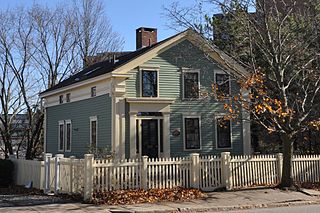
The Lorenzo Crandall House is an historic house in Pawtucket, Rhode Island. It is a 2+1⁄2-story wood-frame structure, built in 1848–49 for Lorenzo Crandall, a carpenter. It features modest Greek Revival styling, including corner pilasters, a wide banded cornice, and molded window caps. It is a well-preserved example of a type of housing that was once quite common in Pawtucket, but is no longer.

The Fifth Ward Wardroom is a historic meeting hall at 47 Mulberry Street in Pawtucket, Rhode Island. It is a single-story red brick building, with a low-pitch hipped roof. Basically rectangular, an enclosed entry pavilion projects from the main block. The building was designed by William R. Walker & Son and built in 1886. Originally used as a polling place and meeting hall, it was later used as a school and by veterans organizations before being converted into a single family residence during its National Register of Historic Places nomination. It was listed on the historic register in 1983.
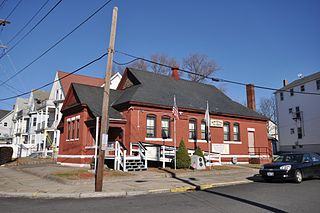
The First Ward Wardroom is a historic meeting hall at 171 Fountain Street in Pawtucket, Rhode Island. It is a single-story red brick building, with a low-pitch gable-over-hipped roof. Basically rectangular, an enclosed entry pavilion projects from the main block. The building, designed by William R. Walker & Son and built in 1886, is one of only three ward halls to survive in the state. Since about 1920 it has been the Major Walter G. Gatchell Post No. 306 of the Veterans of Foreign Wars. The building was listed on the National Register of Historic Places in 1983.

The Fuller Houses are two historic homes at 339-341 and 343-345 Broadway in Pawtucket, Rhode Island. Constructed in 1896–1897, the two Queen Anne-styled homes were constructed as rental properties for the Fuller family and are believed to have originally been identical in construction. The 2+1⁄2-story houses are marked by an octagonal bay which contains the front staircase and a large two-story porch projecting almost completely from the house itself. For the National Register of Historic Places nomination only a single unit was examined, but the identical unit below is believed to have undergone minimal alterations. The other house, 343-345 Broadway, was not surveyed, but has been more seriously modified to allow for four apartment units. The Fuller Houses are architecturally significant as well-preserved and well-detailed Queen Anne-styled apartment flats. The Fuller Houses were added to the National Register of Historic Places in 1983.
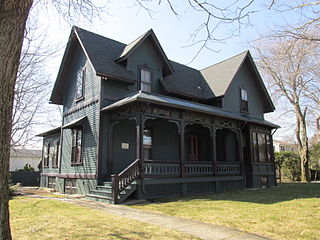
The Louis Kotzow House is a historic house in Pawtucket, Rhode Island. It is a 1+1⁄2-story wood-frame structure, laid out in an L shape. Its exterior is visually busy, with numerous projecting dormer and gable sections, and elaborate woodwork, including bracketed eaves and applied Stick style woodwork on a projecting bay section. Its porch has a delicate jigsawn railing, with a wooden frieze and decorative arches above. The house, built c. 1875, is one of two built by the German Land Cooperative Association, which sought to create a German-speaking enclave in the area.

The Mitchell–Arnold House is a historic house located in Pawtucket, Rhode Island.

Pawtucket City Hall is located at 137 Roosevelt Avenue, just outside the central business district of Pawtucket, Rhode Island. The Art Deco-style building was designed by Providence architect John O'Malley and was built in 1933–1936, its cost subsidized by funds from the Works Progress Administration.

The Charles Payne House is an historic site in Pawtucket, Rhode Island. The house was built in 1855–56 by Charles Payne and later expanded with the addition of two ells and a porch. The 1+1⁄2-story Gothic-Italianate vernacular cottage is architecturally significant as a 19th-century vernacular cottage in a picturesque setting. Though the round-head picket fence and entry gates were later removed, the property retains a large shaded garden on with ample street frontage. The Charles Payne House was added to the National Register of Historic Places in 1983.

The Potter–Collyer House is a historic house at 67 Cedar Street in Pawtucket, Rhode Island. The house, first constructed in 1863, is representative of vernacular architecture of the Pawtucket due to the great modifications to the home which has obscured the original structure of the home. Believed to have begun as a 1+1⁄2-story cottage with a gable roof, subsequent additions and expansions have added a two-story hip-roof addition and greatly altered the floor plan due to enlargement and remodeling. The Potter–Collyer House was added to the National Register of Historic Places in 1983.

The Scholze–Sayles House is a historic house in Pawtucket, Rhode Island. It is a 1+1⁄2-story wood-frame structure, built in 1874–75. It is one of two built by the German Land Cooperative Association, which sought to create a German-speaking enclave in the area. This house is a fine example of Gothic Revival style, and is stylistically similar to the Kotzow House, with a busy exterior that has numerous projecting and gabled sections, and Stick style decoration on a bay window. The interior was extensively redone in 1935 in a Federal Revival style by architect Albert Harkness.

The South Street Historic District encompasses a small enclave of 19th-century houses on South Street between Meadow and Fruit Streets in Pawtucket, Rhode Island. Covering two blocks of South Street, it includes 21 buildings, of which 15 were built before 1850, and the rest before 1900. Most of the houses are 1+1⁄2-story wood-frame structures, with many of the larger ones showing signs of having once been of a similar size. The most common architectural style is the Greek Revival, with notable examples at 19-21 and 37-39 South Street.

St. Mary's Church of the Immaculate Conception Complex is an historic Roman Catholic church complex at 103 Pine Street in Pawtucket, Rhode Island.
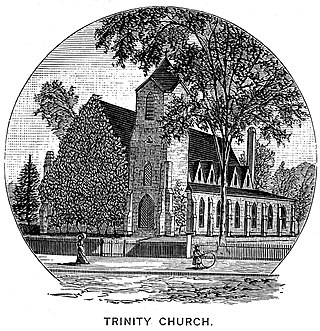
Trinity Episcopal Church was a historic church located at 48 Main Street in Pawtucket, Rhode Island. Built by the Episcopalians, the building was sold to the Catholics in 1977 and became the St. George Maronite Catholic Church within the Diocese of Providence. The church burned down in 2005, and was not rebuilt.






















